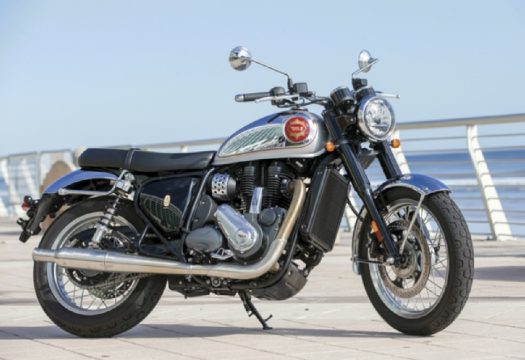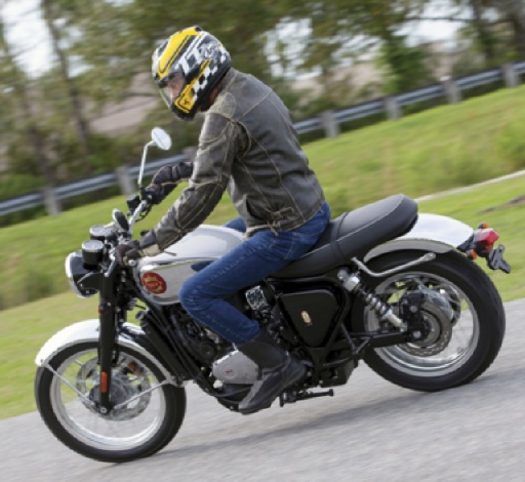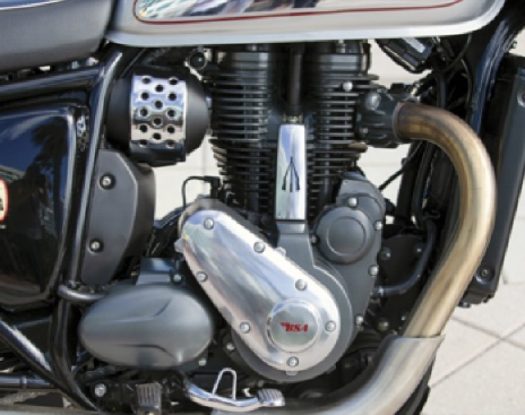
Story by Mark Mederski
Photos by Andrea Wilson

Paying no attention to road tests posted on the internet, or what advertising tells you, why not hop on a new bike and see what you think? No preconceptions. That’s what I did when I got a brief test ride on the new BSA Gold Star. In short, I really like this motorcycle.
Over the past decade, our options in smaller and simpler bikes have grown. There is a plethora of 350s, 400s and 500s from all makers, and they’re selling well if my streetside survey is accurate. But this is something a bit different, this BSA Gold Star. First off, it has a pretty large 650cc DOHC four-valve motor based on a Rotax design, and it’s got some grunt. In fact, after one quick illegal U-turn, I casually whacked the throttle and thought, glad I was holding on. And the power, through accurate fuel injection, is all over, right from the bottom of the rev range. I sensed no vibration; maybe the bar end dampers help with that.
I was so taken with the bike’s appearance, my brain had yet to engage with my questions, like, how does this thing actually ride. In short, it’s one of those, “I wouldn’t change a thing,” motorcycles. Seat to pegs, perfect and I never had to hunt for the shifter or brake pedal. Low bars for nice control and the cafe racer crouch, if needed; perfect. Clutch action, front and rear brakes, familiar, nothing twitchy or grabby, rather linear, just right. The riding position lets you really feel one with this bike. A little throttle and some clutch, you’re off. Feeding in typical body English and moderate counter steering, knee out and the Gold Star responds intu itively, turn after turn. Even those slow ur ban turns around corners, in and out of cars, dodging potholes and man-hole covers will feel right to you. And while bar end mirrors are classic, these upright mirrors on stalks are what you really need around traffic. Singles need some flywheel but clean “carburetion” lets you snap the throttle and be gone. A 1950’s Gold Star has an 82mm x 94mm bore and stroke. This new engine is a much more responsive over-square 100mm x 83mm. Taking a turn a bit too leaned in? Snap the throttle, you’re up and out of the turn, the Pirelli This is a very well-styled, well-finished machine. Its designers ref erenced the original 1950/1960s BSA Gold Stars, the original uni versal street, track and trail bike, and brought it into the 21st century.

By that I mean, the classic lines are there, but instead of zinc- or cad-plated hex bolts, we see a wide use of stainless steel button-head Allen screws and bolts. OK, these are not for purists, but man, they look good. Most of the 650’s engine case bolts are domed hex bolts with integrated washers which are sleek and durable. And if you’re familiar with old British bikes, the speedo and tach gauges here are something to appre ciate. Similar in form to the old Smith’s Chronometrics, they have a certain classic purity and with just one idiot light in each unit, they work to my eye.
Stepping into the future, the battery is an AGM and physically large, which makes me con fident the starter will have the juice it needs to spin the 650cc single motor on a cold day. Up on the handlebar there’s a USB port and, I believe, a plug for your iPhone, plus a cover to keep them both dry. Han dlebar controls for the lights, horn, starter and kill switch are all familiar while down beside the airbox is a cig arette lighter-type plug I’d imagine you could use to source 12-volt power for a heated vest or plug in a battery charging device. OK, these look a bit add-on, but at least these modern conveniences are there, and my late model Honda Africa Twin, at a sub stantially higher price, offers neither. Spare fuses and a tool kit reside under the seat.

Since this bike references the famous BSA Gold Star, one of the most accom plished British motorcycles ever, I must critique its appearance. Having seen hundreds of Gold Stars in my life and knowing the original’s style, I told myself, “Damn, they did a nice job on this bike!” While the tank has moved slightly toward a teardrop form, it’s a good shape, and flawlessly executed. Chrome tank sides outlined with pinstripes marked the higher-end Brit bikes, and BSA had oversized multi-colored badges that at a glance told you about their heritage all the way back to firearms manufacture in Birmingham, England. Studying the tank form against the left-side primary cover, again, this is not your modern shrink fit-styled engine cover. Though smaller, it follows the form of the old BSA primaries, not in tin, but nicely finished cast aluminum. The right side engine cover no longer drives a magneto but instead hides the starter.
The twin plug engine is liquid-cooled and designers did a decent job of hiding the vertical radiator, but the massive and beautiful cylinder and head cooling fins are in place, well, to make me feel good. Doubt they serve any function. The induction equipment is shrouded in a familiar chrome-plated, drilled cover. Exhaust runs through a very large header, likely double-walled for safety, sound reduction and appearance, then exits through a muffler that follows the lines of the original Gold Star street bike, the Clubman. The entire system is stainless steel, though with a brushed finish instead of the old bike’s polished chrome plating; the British did some of the best plating in the world.